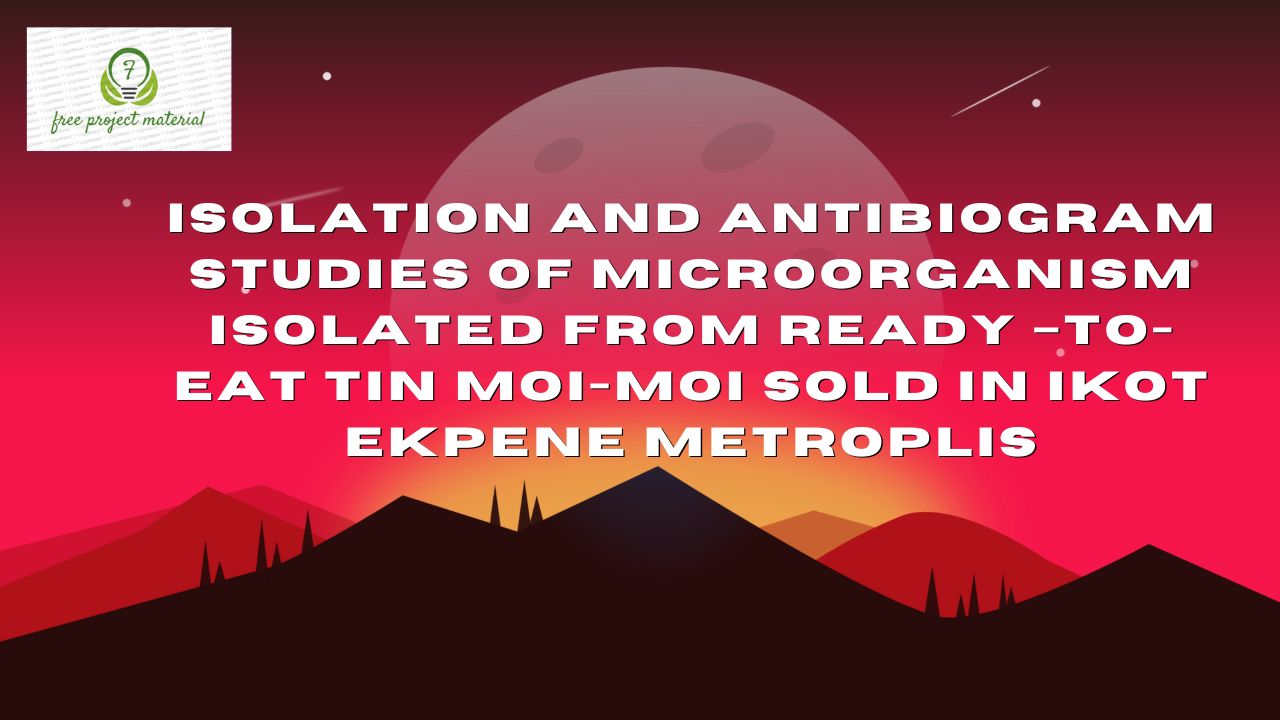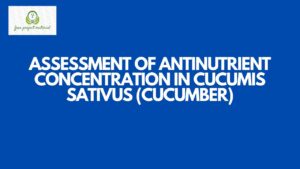ABSTRACT
This study was aimed at isolation and Antibiogram studies of microorganism isolated from tin Moi-moi sold in Ikot Ekpene metropolis. Standard microbiological procedures were employed in accessing microbial contamination in Moi-moi. The result of this study revealed that the highest heterotrophic bacterial count ranged between (4.5 x 104 cfu/ml – 3.0 x 104 while highest heterotrophic fungal count range between 2.8 x 104 cfu/ml- 1.1 x 106 cfu/ml). the bacterial isolates were; Lactobacillus sp, Staphylococcus s, Micrococcus sp, Enterococcus sp, Streptococcus sp, while the fungal isolates were; Aspergillus sp, Penicillum sp, and Fusarium sp. Staphylococcus sp had the highest frequency of occurrence (30.0%) while the least was Enterococcus sp (10.0%). On the fungal isolates Aspergillus sp had the highest (50.0%) and the least was Fusarium sp (20.0%). Moi Moi should be processed, handle, stored under good hygienic condition to prevent contamination.
TABLE OF CONTENTS
Title page- – – – – – – – – i
Certification- – – – – – – – ii
Dedication- – – – – – – – – iii
Acknowledgements- – – – – – – iv
Abstract- – – – – – – – – v
Table of Contents- – – – – – – – vi-viii
CHAPTER ONE: INTRODUCTION
1.1 Background of the study- – – – – – –
1.2 Aims and Objective of the study- – – – –
1.3 Scope and Limitation of the study- – – – –
CHAPTER TWO: LITERATURE REVIEW
2.1 Moi-moi- – – – – – – –
2.2 Preparation of Moi- moi- – – – – –
2.3 Potential Sources of contamination of Ready
To- Eat Moi-moi- – – – – – –
2.3.1 Quality of Ingredient- – – – – – –
2.3.2 Contaminated Food Process- – – – – –
2.3.3 Unhygienic Vending Practices and Conditions- – –
2.4 Food Safety to Ready- to- eat Food- – – – –
2.5 Microbiological Review of Different Ready – to- eat Food- – – – – – –
CHAPTER THREE: MATERIALS AND METHODS
3.1 Sample Collection- – – – – – –
3.2 Sterilization of Glass Wares and Media – – –
3.3 Microbiological Analysis- – – – – –
3.3.1 Serial dilution of the sample- – – – – –
3.3.2 Cultivation of Bacterial- – – – – – –
3.3.3 Purification of Bacterial — – – – – –
3.3.4 Enumeration of Bacterial Isolates- – – – –
3.3.5 Characterization and Identification of
Bacterial and Isolates- – – – – – –
3.3.6 Characterization and Identification of Fungal isolates- –
CHAPTER FOUR: RESULT AND DISCUSSION
4.1 Results – – – – – – – – –
4.2 Discussion- – – – – – – – –
CHAPTER FIVE: CONCLUSION AND RECOMMENDATION
5.1 Conclusion – – – – – – – –
5.2 Recommendation- – – – – – – –
References
CHAPTER ONE
INTRODUCTION
1.1 Background of the study
Occupied work schedules and activities of majority of people, convenience in accessibility and affordability have necessitated food consumers to resort to street vended foods for survival in their day to day activities. These street foods are often ready-to-eat (RTE) varieties of food sold in streets or other public places such as markets and from a portable food booth or truck by hawkers or vendors also stated that Street food are ready-to-eat food and beverages prepared and sold by vendors and handlers especially in streets and other related public places for immediate consumption or consumption at extended period without further processing. However, some street foods are regional while many are not; having spread beyond their region of origin.
Have related that most street foods is classed as both finger food and fast food which are mostly cheaper on average than restaurant meals.
Others may purchase street food for few numbers of reasons, such as to obtain reasonably priced and flavourful food in a sociable setting, to experience diverse ethnic cuisines and for nostalgia. Extensive street vending of foods in Nigeria have been attributed to several factors such as deterioration of rural living conditions, urban migration, urban congestion, long commuting distances between the workplace and home, unemployment, lack of cooking knowledge, changes in family cohesion and a shortage of establishments that serve reasonably priced food close to the workplace. Street-vending of food provide a major source of income for a vast number of persons, particularly women involved in the business, thus importantly served as a self-employment opportunity specifically for low capital investors. Besides, it provides affordable and most accessible means of obtaining a nutritionally balanced meal outside the home for many low-income people (Rane, 2011).
Moi-moi as a food can be consumed as breakfast snack with pap alone, and with other cereal foods like rice in most Nigerian homes. The aforementioned food is an excellent source of nutrient and can be consumed anytime of the day. Food packaging entails the act of wrapping or enclosure of food in materials. Materials such as papers, leaves, polyethylene, glasses, aluminum foil and has been recognized as most used materials for food packaging due to their ability to preserve and shield food from outside influences and damage while providing consumers with the nutrients required. Wrapping/packaging materials like plastic, waterproof and aluminum foil are used in packaging quick consumed food products like Moi-moi.
Due to scarcity in urban areas where they are highly demanded, Moi-moi is mostly packaged in tin containers and flexible plastics like polyethylene film bags, aluminum foils and plates to meet higher demands in this area due to change in lifestyle of people. However, it has been discovered that these aforementioned packaging materials leaves desirable imparts or undesirable flavour component into food products which can either enhances product acceptably unlike undesirable one. Acceptability of Moi-moi depends on appearance color, taste, aroma and texture which are the major parameters that determine product quality
1.2 Aims and Objective of the study
1.2.1 Aim of the Study
The aims of this study is to carryout isolation and antibiogram of microorganism isolated from ready to eat tin moi- moi sold within Ikot Ekpene metropolis.
1.2.2 Objective of the Study
- To isolate microorganisms from ready to eat moi-moi.
- To characterize and identify the microorganism from ready-to-eat moi-moi
- To carryout antibiogram on the isolated microorganisms.
- To provide useful recommendation on proper handling and display ready-to-tin moi-moi.
1.3 Scope and Limitation of the study
Due to time, lack of adequate facilities and financial constraints this research project is limited to isolation and antibiogram studies of microorganism isolated from ready to eat tin moi-moi sold within Ikot Ekpene metropolis.



